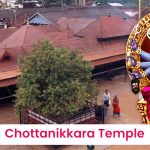Koragajja Temple is dedicated to Koraga Thaniya, a Tulu deity of Dravidian provenance. Thaniya is more of a historical figure than a mythological one. Dravidians have worshipped their ancestors since ancient times, and Koragajja is regarded as an ancestral deity by the people of Tulu Nadu, which is a region on the southwestern coast of India. It is also a proposed state which comprises parts of Karnataka and Kerala. Mangalore is the largest city in Tulu Nadu, and the people of this territory are called Tuluver. They speak the Tulu language.
The Tulu people turn to Koraga Thaniya to recover things that they misplaced or lost, to resolve issues, and to facilitate some work. Koraga Thaniya is popularly called Koragajja. “Koraga” is the community name, while “Ajja” is the Tulu term for ‘elderly man’. Though he attained divinity during his middle age, people called him Ajja out of affection.
The Story of Koragajja
Koraga Thaniya lost his parents at a very young age. He was a mere infant when his mother died. His father passed away a little later. Left to his own devices, the young boy began traveling southwards. He would sit under a tree, and when hungry, he would eat sand. Sometimes, overcome by loneliness, he would cry.
Once, a woman called Bairakke Baidyedi and her family passed by the tree under which Thaniya was sitting. Seeing his plight, they approached him, but he ran away in fear. However, they managed to win his confidence and gave him some clothes to wear. He told Bairakke Baidyedi that he was an orphan, and the woman felt compassion toward the child. .
Bairakke Baidyedi invited Thaniya to accompany them and assured him that she would treat him like her own son. The child agreed. Once he started living with them, Bairakke noticed significant growth in her business. The child also learned to make baskets, bamboo stuff, and other handmade items and began to sell them.
One day, a festival called Nema or Bhoota kola was organized for Marlujumadi, Maisandaya, and Kinnikodangade Daivas, which were associated with Bairakke’s family, at the nearby temple.
This is an annual ritual performance among Tuluvers where local spirits or deities, called bhootas or daivas, are channelized by people (specialists in rituals) from certain scheduled castes like the Nalike, Pambada, or Parawa communities. While ‘kola’ refers to the worship of a single spirit, Nema involves several spirits in a hierarchical order. During Kolas and Nemas, the spirit mediates and adjudicates family and village disputes
Bairakke’s family had to provide coconut leaves, tender coconuts, and banana plants to the temple for the ceremony. But there was no one to carry them as they were quite heavy, requiring at least 7 people. But Thaniya agreed to carry these leaves on the condition that he would get to eat the food meant for all 7 people.
After eating, he went to the temple carrying the leaves and plants. Thaniya did it out of love and gratitude for Bairakke, who treated him like her own child. Seeing Thaniya from a distance, the temple chief told him to keep the leaves near the temple. He also told Thaniya to stay far away from the temple, as he hailed from a lower caste.
Thaniya felt bad. He asked, “The things which I brought are acceptable, but not me? You are making me stand far away because I belong to a lower caste.”
The people present ignored Thaniya’s words. Thaniya then went and stood near the temple. He noticed a tree laden with fruits. He recalled that his mother had wanted the fruits to make some pickles.
He decided to pluck the fruits and tried to climb the tree. As he could not reach the branch, he kept one foot on the temple’s kalasha. The deity inside the temple became angry and made him vanish. In this way, Thaniya attained divinity. Later, people began to worship him as Koragajja/ Neecha Daiva throughout Tulu Nadu.
The Architecture of Swami Koragajja Temple
Swami Koragajja Temple is a simple structure. But the deity supposedly has immense powers.
Festivals of Swami Koragajja Temple
When Koragajja fulfils a devotee’s wish, they offer Annadaan (food donation to the needy), and perform acts like ear piercing, tonsuring the head, etc. The temple also conducts mass marriages and provides educational facilities for poor children.
The Kola festival is a cultural event that is done to appease the deity. This is held every year for the well-being of the community. There are many ritualistic activities, including song and dance, during the festival.
Benefits of Swami Koragajja Temple
Korajja is a prominent deity in Tulu Nadu. The deity is regarded as the spirit of the Tulu Nadu region. It is the presiding deity of most of the households here. The Tulu people consider Koragajja’s blessings essential to lead a smooth life.
When people face problems in the family, business, or health, or if they face delays in completing something, they pray to the Swami, hoping that he will resolve the issue. They also pray to Koragajja when they lose something valuable.
How to reach Swami Koragajja Temple
By Air
Mangalore is the nearest airport. It is connected to many cities. Taxis are available at the Mangalore airport, and you can book a cab to Udupi.
By Rail
Udupi railway station is well-connected to many cities. You can take a cab to the temple from there.
By Road
There are plenty of buses to Udupi. Cabs and autos are available to reach the temple from the city bus station. Udupi is on NH66. Those traveling from Bangalore have to go through Shiradi Ghat on NH48.
Temple Timings
The temple is open on all days: 07:00 am – 07:00 pm


